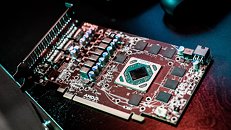Thursday, June 16th 2016

AMD "Ellesmere" ASIC Pictured Up Close in RX 480 PCB Picture Leak
AMD's all-important Polaris10 "Ellesmere" ASIC is pictured up close in a 3-quarter PCB shot of the upcoming Radeon RX 480 / RX 470. The picture reveals the ASIC with a die that's significantly smaller than that of the 28 nm "Tonga" silicon. The "Ellesmere" die is built on the 14 nm FinFET+ process. The die is seated on a substrate with a 256-bit wide GDDR5 memory interface. This appears to be a common reference PCB between the RX 480 and the RX 470.
The RX 480 ships with a classy looking lateral-flow cooler that's longer than the PCB itself; while the RX 470 uses a more common fin-stack top-flow cooling solution. Of course both cards are expected to ship with custom-design boards and cooling solutions. The reference PCB draws power from a single 6-pin PCIe power connector, and uses a 6-phase VRM to condition it for the GPU and memory. Display outputs include three DisplayPort 1.4 and one HDMI 2.0a connectors. There are also unused traces on the PCB for a DVI connector, so it's likely that some custom-design cards could feature it.
Source:
VideoCardz
The RX 480 ships with a classy looking lateral-flow cooler that's longer than the PCB itself; while the RX 470 uses a more common fin-stack top-flow cooling solution. Of course both cards are expected to ship with custom-design boards and cooling solutions. The reference PCB draws power from a single 6-pin PCIe power connector, and uses a 6-phase VRM to condition it for the GPU and memory. Display outputs include three DisplayPort 1.4 and one HDMI 2.0a connectors. There are also unused traces on the PCB for a DVI connector, so it's likely that some custom-design cards could feature it.

73 Comments on AMD "Ellesmere" ASIC Pictured Up Close in RX 480 PCB Picture Leak
@cdawall
Why do you think it would be "Fury replacement"? (at stock)
I could see 300$ (1500+) version going there, but don't 1266Mhz leaks show it somewhere at 980 (stock), and even slightly below it?
This card is an R9 390 replacement at a better price.
Vega will bring the Fury replacement cards. Only these will be called the RX 490/x this time.
I don't expect much better performance than the R9 390 if both cards are clocked the same in DX11 titles. This card will sit firmly in the R9 390x performance range but it's clockspeeds will help it pull away in some games.
odd/annoying that the cooler is longer than the PCB.
1- thermal headroom (dictates form factor)
2-die size (effects cost of production)
3- performance (number of cores/sps and clockspeed dictate this)
So in a gpu, engineers want to design power efficient sps to cram as many of them before reaching thermal headroom, but at the same time you want to clock them as high as you can as well in order to build reasonably priced/smaller chips that perform well. So there is always a trade off.
The question i presented here, is wether you believe clockspeed is a design decision by Amd, or is due to the variance between 14nm glofo and 16nm tsmc, id appreciate it if you stop refuting what you are assuming im trying to say(bash amd, which I'm not) and instead contribute to the conversation by answering my question.
Is amd prioratizing core count and bigger die with lower power over smaller chips with higher clocks and higher power?
And i also pointed out that I wonder if 14nm glofo having slightly higher density and possibly lower cost effected that decision from AMDs side.
Again sorry for the confusion, but you guys seriously didnt get what i was trying to say initially, but i hope you do now :)
clockspeed alone means nothing, you cannot use it as a reference between different models of the same GPU, let alone different GPU designs.
More things at lower clock or less at higher clocks is a design decision, with neither way being clearly "superior".
If RX 480 OCing rumors are true, AMD has clearly "first chips released" round, with 15-20%-ish boost from OC, vs 10-14%-ish from nVidia.
Just like regular CPUs, there is a limit to how much parallel work can be accomplished on a GPU. There is an argument that could be made that despite similar shader counts, the fact that nVidia used fewer SMs clocked higher yielded a better benefit than more CUs clocked lower (also with fewer shaders per CU.)
So with that said, I think there is a lot more that goes into this than clock speed, or even hardware for that matter. How the drivers and applications dispatch any instructions to the GPU has just as much to do with it as the way the hardware is setup... but simply put, the only time you can boil everything down to clock speed is on the same architecture.
tl;dr: GPUs do have "cores", they're just a little different than traditional CPU cores and they're not the shaders though, they're the CUs and SMs.
Maybe that is an illusion.
Either way, all of this is besides the point. I don't think anyone really understands what @sergionography is trying to say and all I'm saying is this:
Oh well at the end of the day I just got a 980Ti for my PC at work so I am going to enjoy that
Lol because I so need a 980Ti to run web browsers.